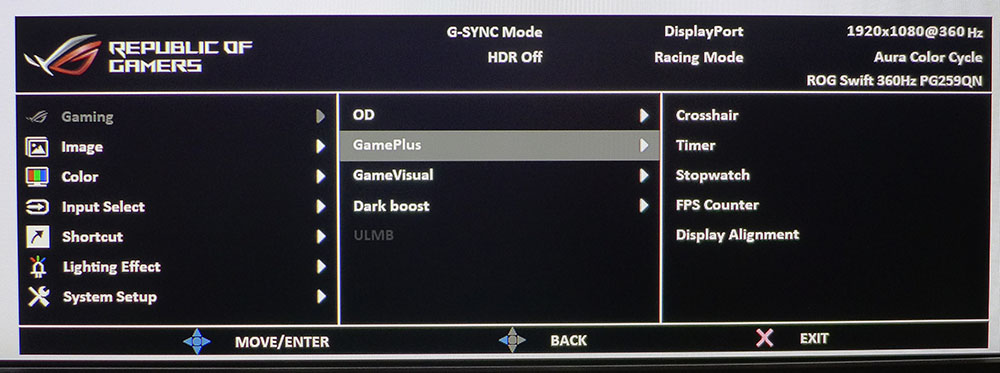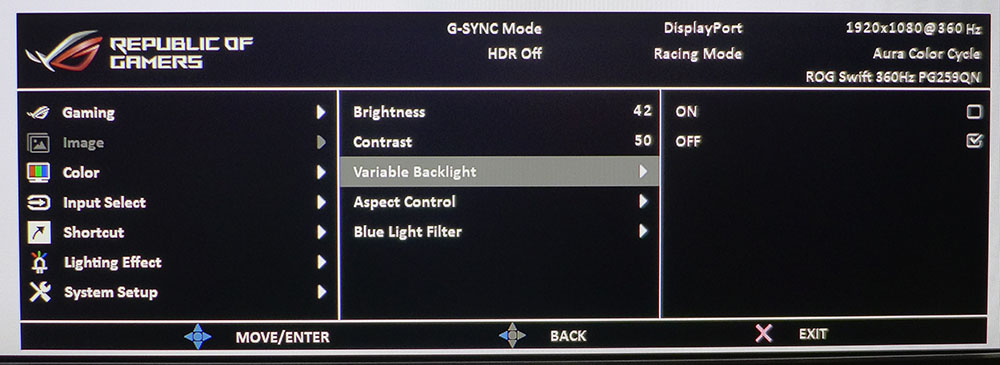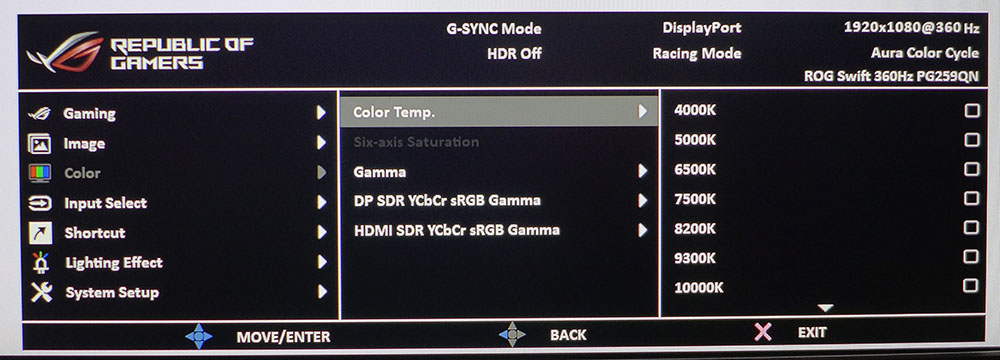Tom's Hardware Verdict
Gamers with the graphics and financial capabilities will flock to the Asus ROG Swift PG259QN. Its tremendous speed and response, courtesy of a 360Hz refresh rate and Adaptive-Sync, will make you a better gamer. With accurate color, solid contrast and decent HDR, it is one of the best pure gaming monitors we’ve reviewed to date.
Pros
- +
Excellent IPS contrast
- +
Unparalleled speed and response
- +
Decent HDR
Cons
- -
No extended color
- -
Expensive
Why you can trust Tom's Hardware
The quest for speed pervades almost every aspect of computer tech. Each new component that comes along can go faster and process more data than what came before. A smartphone can store much more information and perform exponentially more operations per second than the computers that took three men to the moon in 1969.
Gamers know this better than anyone. Any title that renders its on-screen environment in realistic detail needs a lot of speedy hardware, and that includes the monitor. We’ve reviewed many of the fastest and best gaming monitors since Asus debuted its VG248E in 2013. Running at a 144 Hz refresh rate, it represented a new way of looking at gaming monitors. Today, we’re looking at another breakthrough, the 360Hz Asus ROG Swift PG259QN (currently $699). Yes, it really runs at 360 Hz. And the results for a gamer are remarkable.
Asus ROG Swift PG259QN Specifications
| Panel Type / Backlight | IPS / W-LED, edge array |
| Screen Size & Aspect Ratio | 24.5 inches / 16:9 |
| Max Resolution & Refresh Rate | 1920 x 1080 @ 360 Hz; G-Sync 1-360 Hz |
| Native Color Depth / Color Gamut | 8-bit / sRGB, HDR10 |
| Response Time (GTG) | 1ms |
| Max Brightness | 400 nits |
| Contrast | 1,000:1 |
| Speakers | None |
| Video Inputs | 1x DisplayPort 1.4, 1x HDMI 2.0 |
| Audio | 3.5mm headphone output |
| USB 3.0 | 1x up, 2x down |
| Power Consumption | 31w, brightness @ 200 nits |
| Panel Dimensions (WxHxD w/base) | 21.9 x 14.9-19.6 x 9.7 inches (557 x 379-499 x 247mm) |
| Panel Thickness | 2.3 inches (59mm) |
| Bezel Width | Top/sides: 0.2 inch (6mm); Bottom: 0.7 inch (18mm) |
| Weight | 15.6 pounds (7.1kg) |
| Warranty | 3 years |
Aside from its speed, the main topic of conversation about the PG259QN is likely to be its price. At $699, it’s one of the more expensive monitors with 1080p resolution out there. But when you consider that nothing else can do what it does, what’s a gamer to do? If you’re looking for every possible competitive advantage, this display will change your perception of an LCD screen’s capabilities.
We accept a certain amount of motion blur from our monitors. The technology, no matter how well-evolved, does have a significant limitation: sample and hold. This means that there is no blanking of the screen between frames like with a plasma, OLED or CRT screen. A plasma flashes the image up to 600 times per second, which completely eliminates blur. OLEDs can do much the same thing. But the only way to mimic this with an LCD is to either strobe the backlight or up the refresh rate.
Backlight strobes are common in gaming monitors, and they do work at removing blur. But they also reduce brightness and, in most cases, prevent the operation of Adaptive-Sync, (like Nvidia G-Sync or AMD FreeSync). Higher refresh rates are a better approach, and the faster you go, the less blur there is. Of course, you need a PC that can attain high frame rates, and that adds to the cost. To drive the ROG Swift PG259QN at 360 frames per second (fps) will require use of one of the best graphics cards available to gamers. But if you can do this, you’ll be rewarded with the smoothest image you’ve ever seen. Just running a few Blur Busters tests demonstrates the capability of the PG259QN. It’s on another level.
In addition to its lofty refresh rate, Asus included G-Sync, which operates over the full range from 1-360 Hz. We also got the monitor to run FreeSync unofficially, even though it’s not certified by AMD. You also get HDR with a dimmable backlight. It’s an edge array, so no one’s expecting it to be the best HDR monitor or offer the dramatic contrast possible with a full-array local dimming (FALD) panel, but the results may still surprise you.
The PG259QN might be a harbinger of things to come, just like the VG248 was seven years ago. Let’s take a look.
Get Tom's Hardware's best news and in-depth reviews, straight to your inbox.
Assembly and Accessories
The ROG Swift PG259QN ships in a large carton and only requires you to bolt up the all-metal base. The upright is already attached.
Unlike other ROG Swift displays, there is no RGB lighting effect to project onto the top of your desk. Not that we really miss it.
The monitor comes with one USB, one DisplayPort and one HDMI cable, along with a small external power supply. A snap-on cover goes on the input panel to keep the wiring tidy.
Product 360
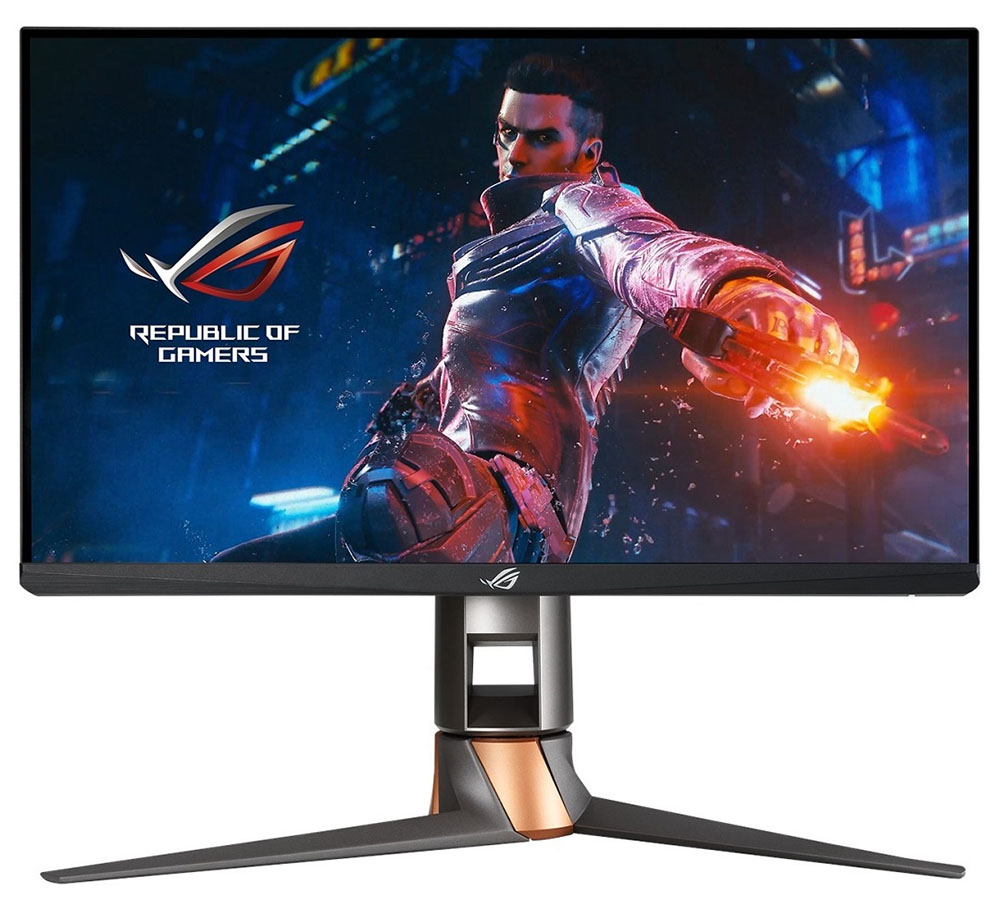
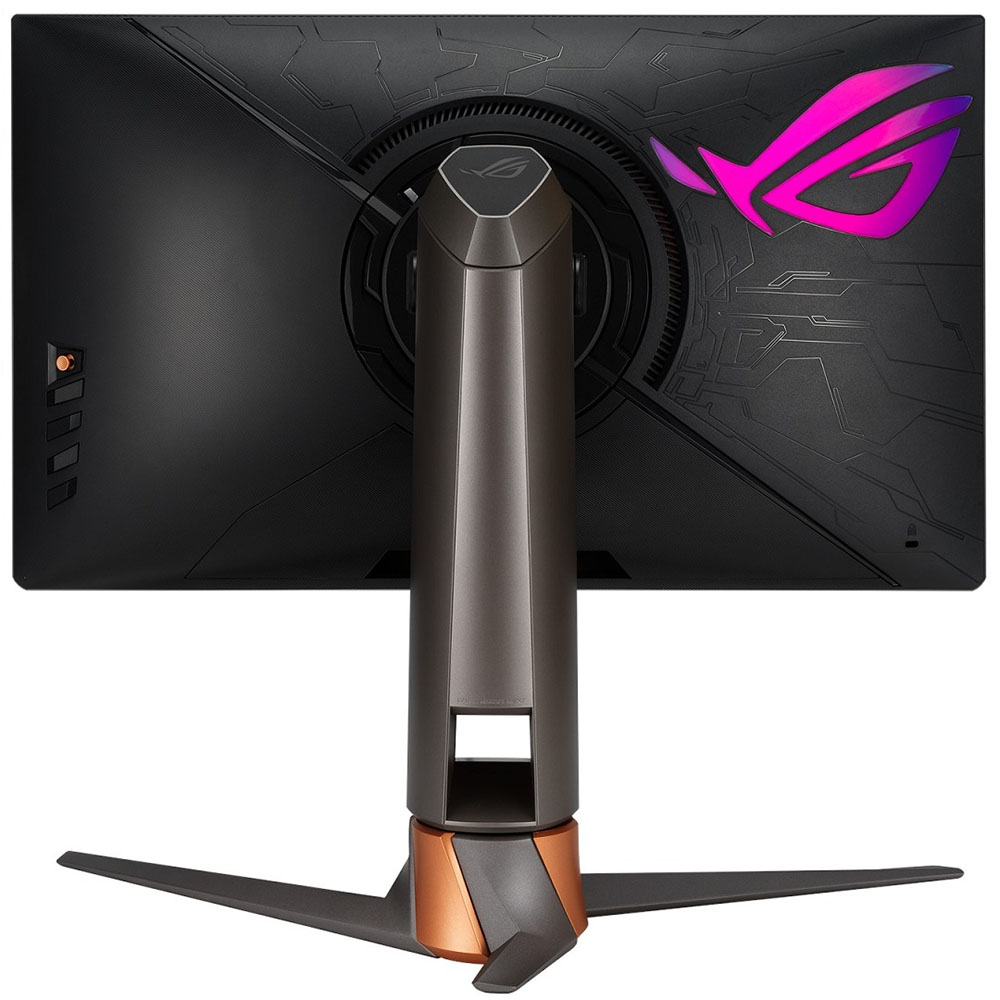
Asus achieves an extremely thin bezel around the top and sides, just 6mm. If you installed two or three PG259QNs, you wouldn’t have much line between images. The bottom trim strip is 18mm wide and features the ROG logo in a polished metal finish. Overall styling is distinctly Asus, with a smooth curve across the back and molded feature lines that look like the hull of a spaceship.
In back is a much larger ROG logo that lights up in different colors. The effect is called Aura RGB and is controllable from the monitor’s on-screen display (OSD). The light can breathe or flash and change color. If you engage Aura Sync and have compatible ROG hardware, you can sync the RGB effects.
Also in the back is a control joystick, plus four buttons. The lowermost key toggles the power, so take care not to click it by mistake. But the stick controls all functions with ease. Two of its directions are shortcuts programmable by the user.
The stand is quite substantial and styled to fit in with the ROG theme. You get 4.7 inches of height adjustment, along with a 25 degree swivel, 5/20 degrees tilt and a portrait mode. If you want to use your own mount, the upright can be removed to reveal a 100mm VESA lug pattern.
The input panel is sparse and features just one each of DisplayPort 1.4 and HDMI 2.0. You also get a 3.5mm audio output and USB 3.0 ports, one upstream and two down. HDMI operates up to 240 Hz only; you’ll need DisplayPort to run at 360 Hz and to use G-Sync. HDR works over either interface.
OSD Features
The ROG Swift PG259QN’s OSD delivers everything needed for gaming and accurate imaging. You control it with a handy joystick, which you’ll find around the back-right side, along with a set of control keys.
Gaming is front and center, of course. There are three overdrive levels available. The middle setting is the best choice for ghost-free motion. GamePlus includes a set of aiming points, timers, a stopwatch, frame rate counter and multiple display alignment marks. Dark Boost raises the black level to make shadow detail easier to see.
There's also Ultra Low Motion Blur (ULMB), though at frame rates over 200 fps it’s completely unnecessary. To use it, turn off G-Sync and lower the refresh rate to 240 Hz. Then, you can adjust the pulse width for more or less blur reduction. More reduction means lower brightness.
The PG259QN includes a dynamically dimmable backlight for both SDR and HDR modes. In SDR mode, it increases contrast to around 3,000:1, which makes a visible difference. HDR contrast measured nearly 7,000:1 in our testing, so the feature does have an impact. How much will depend on the content, but we found it enhanced gaming and video nicely. This menu also includes a blue light filter for reading.
The PG259QN is accurate out of the box, but Asus included a nice set of calibration controls. You can specify the color temp using one of seven presets or adjust the RGB sliders. There are also five gamma presets from 1.8 to 2.6. HDR locks out most image controls, but you can still adjust contrast and color temp.
Asus’ Aura lighting effects have their own sub-menu. Turning on Aura Sync coordinates the PG259QN’s LED with that of other ROG components. so you can have a light show coming from all your gear. Aura RGB controls only the large ROG logo in back. with color changes that come in user selected effects. If you wish, you can turn the whole thing off.
Asus ROG Swift PG259QN Calibration Settings
The ROG Swift PG259QN’s Racing mode provides a reasonably accurate image without calibration and is the best starting point for adjustment. Leaving Contrast on the default of 50 and gamma at 2.2, we tweaked the RGB sliders in the User color temp memory for a very nice gain.
Below are the calibration settings we used for SDR content.
| Picture Mode | Racing |
| Brightness 200 nits | 42 |
| Brightness 120 nits | 21 |
| Brightness 100 nits | 16 |
| Brightness 80 nits | 11 |
| Brightness 50 nits | 3 (minimum 40 nits) |
| Contrast | 50 |
| Gamma | 2.2 |
| SDR Color Temp | Red 95, Green 94, Blue 100 |
| HDR Color Temp | 6500K |
It should be noted that when switching to HDR mode, most image controls are grayed out, but you can still adjust contrast and color temp. And your SDR settings are inherited by HDR mode. Our custom grayscale calibration was not the best choice for HDR, so we changed the color temp back to 6500K.
Gaming and Hands-on
The first thing we noticed when connecting the ROG Swift PG259QN is that it’s a breeze to install. With no intervention from us, Windows recognized its 360Hz capability and set the rate accordingly with G-Sync engaged. AMD FreeSync was the same, even though this isn't AMD-certified as a FreeSync monitor. There was no overclock or OSD toggle to configure. With our test systems, it just worked.
Regardless of what you might do with the PG259QN, it’s an excellent monitor. We spent a few days working on spreadsheets and documents, watching videos and playing games, and it excelled at everything. Color and contrast are equal to the best IPS screens we’ve reviewed. Its lack of an extended color gamut, namely DCI-P3, was not a detriment. sRGB, when done accurately, provides plenty of saturation and vivacity for photo editing and graphics-oriented tasks.
Windows looks best in SDR with the variable backlight turned on. Asus has engineered a practical dynamic contrast feature that makes the picture bright and sharp without clipping detail or muting color.
HDR mode should be reserved for gaming and properly encoded video. There is no point to engaging HDR to watch SDR clips from YouTube; it won’t look any better. But if you select a premium stream, HDR mode will enhance it. The variable backlight is locked to the on position when you switch Windows to HDR.
Gaming is a revelation on the PG259Q. In most cases, frame rates stayed in the 240-260 fps range. You’ll need substantial hardware to run at 360 Hz -- more than the GeForce GTX 1080 Ti and Radeon RX 5700 XT cards we have on hand. But sustained action at even 250 Hz is eerily smooth. You will quickly forget about the monitor’s FHD resolution because objects and backgrounds stayed in perfect focus, no matter how quickly we moved the mouse. Motion resolution is everything, and this monitor does it better than anything we’ve yet seen.
Tomb Raider definitely benefitted from the variable backlight. It added some extra pop and helped shadow detail stand out as well, while still rendering a deep black when appropriate. Call of Duty: WWII looked good in HDR mode with better delineated dark areas and a dimensional pop from highlights. This effect made textures stand out, adding to the 3D look.
Control lag and motion blur were completely absent. And that is no exaggeration. The picture was every bit as sharp when moving as when standing still. And this was at frame rates below the PG259QN’s full capability. The highest peak we saw was 295 fps with detail maxed. While we could have turned the detail down for higher rates, the game then looked a little soft, even when static.
Those concerned about the heat generated by a 360 Hz refresh rate need not be. Asus installed a substantial heatsink on the PG259QN that eliminates the need for a fan. Indeed, we did not hear a peep from the PG259QN, even when it had been fragging away for several hours.

Christian Eberle is a Contributing Editor for Tom's Hardware US. He's a veteran reviewer of A/V equipment, specializing in monitors. Christian began his obsession with tech when he built his first PC in 1991, a 286 running DOS 3.0 at a blazing 12MHz. In 2006, he undertook training from the Imaging Science Foundation in video calibration and testing and thus started a passion for precise imaging that persists to this day. He is also a professional musician with a degree from the New England Conservatory as a classical bassoonist which he used to good effect as a performer with the West Point Army Band from 1987 to 2013. He enjoys watching movies and listening to high-end audio in his custom-built home theater and can be seen riding trails near his home on a race-ready ICE VTX recumbent trike. Christian enjoys the endless summer in Florida where he lives with his wife and Chihuahua and plays with orchestras around the state.
-
Dayne_87 That's great, but I prefer resolution over frame rate. I have a 1440p Asus ROG 27" with 144hz and G-sync and I'm fine with that for now. If I were going to upgrade for that price I would want it to be at least 1440p 360hz or 4k 144hz or faster and still 27".Reply -
thepersonwithaface45 No idea why companies are focusing on high refresh rates at 1080p. This is the 4k generation, 2k was last gen and we should be getting more choices in the 4k range. Which I'm sure we will, but I don't see anyone paying $700 for a 1080p high refresh rate monitor when for $100 more you can get a 144hz 4k 27" monitor.Reply
Infact, this one is only 24.5"?
What? What is that price for that resolution, you're really just paying for 360hz? -
Jonagold What are all the included latencies in your Absolute Input Lag testing? Could there potentially be mouse button latency included? Also system latency? What are frame-times etc.?Reply -
ashburner This is for competitive gamers and that's it. They are notorious for running high framerate at low resolution. Even at 1080p, almost all effect settings are turned off. It's kinda crap to watch but it works for them. I prefer 2K at 27". I'm at 165hz now but I'm looking at a 4K 27". My 3080 should be in on Tuesday.Reply -
nofanneeded I dont know whats stopping Tomshardware from reviewing LG Oled 4K 55 inch TV for gaming ? it has everything one needs for gaming even Nvidia Gsync.Reply -
mdrejhon Founder of Blur Busters / Inventor of TestUFO here.Reply
I should compliment Toms Hardware for improved mainstream-writing description of how motion blur is reduced -- doubling Hz halves display motion blur, as an alternative to strobing. Yesterday's media used to dismiss high Hz, or was not familiar with the benefits of high Hz.
I would, recommend that TomsHardware do pursuit camera tests with instructions at the forums:
https://forums.blurbusters.com/viewforum.php?f=23(Even an iPhone works as a pursuit camera!) -
mdrejhon Reply
Not necessarily. If you own a 120Hz iPad, you'll notice web browser scrolling is 2x clearer. LCD motion blur halves when LCD Hz doubles. And my 360 Hz monitor has 1/6th web browser scrolling motion blur of a 60 Hz LCD monitor.ashburner said:This is for competitive gamers and that's it.
I have the PG259QN here too, and it's absolutely lovely, especially when combined with the Razer 8000 Hz mouse (I have a prototype here).
4K was a $10,000 frivolity in 2001. Today, 4K is a $299 Walmart special. The mainstreaming of 120 Hz is slowly beginning this decade, with future iPhone/Android devices standardizing at least 120 Hz. But eventually, 240 Hz will be a freebie feature much like Retina screens.
We've almost retina'd out resolution, but we are far away from retina refresh rates. There is already a laboratory engineering path to an 8K 1000Hz display, though that will take many years of progress to reach.
High-Hz isn't just for esports anymore. Though the highest Hz is still expensive and mainly of interest to bigger-budget users. -
CaesarNaykid Reply
I was going to post about your site. My eyes hurt and I cringe every time i see sideways pans in films and I check your site from time to time to see how the race to 1000hz is going. I get why these people like higher resolutions, but even back in the day of the 3DFX Voodoo1 and Voodoo2 SLI I preferred higher framerate over the resolution bumps. I want to see that 1000 hz target hit and this is a positive step that moves the bar even if just a bit towards the goal we need in display technology.mdrejhon said:Founder of Blur Busters / Inventor of TestUFO here.
I should compliment Toms Hardware for improved mainstream-writing description of how motion blur is reduced -- doubling Hz halves display motion blur, as an alternative to strobing. Yesterday's media used to dismiss high Hz, or was not familiar with the benefits of high Hz.
I would, recommend that TomsHardware do pursuit camera tests with instructions at the forums:
https://forums.blurbusters.com/viewforum.php?f=23(Even an iPhone works as a pursuit camera!)

